Frequently Asked Questions
-
1. General
-
1.1. Where can I buy Maak products?
Where can I buy Maak products?
Maak fabrics and wallcoverings can be purchased online through our website or through interior designers, retailers and drapery/furniture fabricators.
We recommend using professional advice as they will be able to provide you with a wealth of advice and guidance and ensure your Maak fabric or wallpaper is made up or installed into a high quality finished product.
-
1.2. Who are trade customers?
Who are trade customers?
Trade customers are bona fide interior design or soft furnishing retail/workroom/manufacturing businesses who use fabrics or wallpapers in their products or design projects and/or resell to retail customers.
If you would like to use Maak fabrics or wallpapers in your business, please contact us, or complete the online registration form.
We will be able to give you more information once we have verified your trade status.
-
-
2. Print Base Information
-
2.1. Where are your print bases from?
Where are your print bases from?
Our fabrics and wallcoverings are sourced from all over the world. In co-operation with our mills we have developed a broad range of textiles and wallcoverings covering a wide variety of uses across the residential and commercial sectors of the interior design trade.
-
2.2. Do your fabrics fade?
Do your fabrics fade?
All printed fabrics will invariably fade over time if exposed to extended periods of UV light. While our fabrics exceed industry standards for lightfastness we do not recommend them for fixed outdoor upholstery. MAAK's natural fabrics are printed with pigment inks giving them excellent lightfastness.
-
2.3. What is pilling?
What is pilling?
Pilling occurs where short or loose fibres on the surface of a fabric tangle together and form small balls or “pills". Pilling is a result of abrasion caused by normal wear and cleaning and should not be considered a fault. Pilling can be minimized by vacuuming furniture regularly to remove dirt and grit, by turning items inside out when washing, and by using a fabric softener when washing.
Pilling can be successfully removed with battery operated pilling tool which is available in most haberdashery stores. Removal of the unsightly balls does not affect the performance of the fabric.
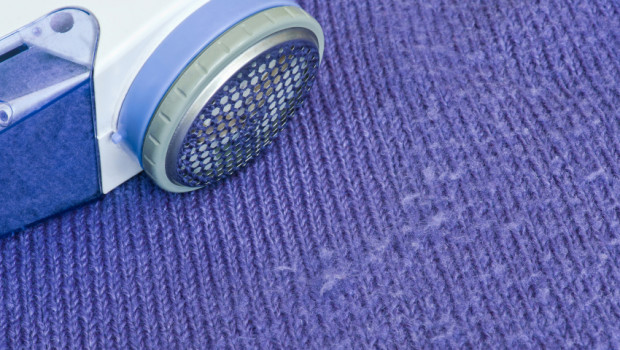
-
2.4. What is surface hair?
What is surface hair?
Surface hair is loose fibres on the print surface of natural fabrics. Every effort is made to remove surface hair however as the pruduction of natural fabrics is imperfect due to the nature of natural fibres some surface hair can remain and disrupt the print. This is a characteristic of natural fabrics and not considered a flaw.
-
2.5. Are your fabrics suitable for outdoor use?
Are your fabrics suitable for outdoor use?
MAAK's high-performance fabrics are suitable for occasional outdoor use. This means that you can use them as outdoor cushions or banquettes which are generally stored undercover out of the elements.
Our fabrics are not suitable for fixed outdoor upholstery.
-
2.6. Are your fabrics machine washable?
Are your fabrics machine washable?
All our fabrics are machine washable.
General washing instructions call for a cold wash and line dry however this is dependant on the fabric used.
Please refer to the information sheet for the fabric or email hello@maaktextiles.com for further details.
-
-
3. Ordering, Payment & Shipping
-
3.1. How do I order?
How do I order?
The easiest way to order is through our website.
Create your colourway
Select your substrate
Choose your desired meterage
Add your order to the cartOnce your finished simply go to the cart and follow the prompts to complete your order.
Alternatively you can email us at hello@maaktextiles.com to place your order. Be sure to provide us with a design, colour code, substrate and required meterage.
-
3.2. What is the minimum order?
What is the minimum order?
Our minimum order is 1 meter (yard). After that you are welcome to order in 0.1 mt (yd) increments.
-
3.3. Can I cancel or change my order?
Can I cancel or change my order?
Once your order has entered production you will not be able to amend the order.
-
3.4. How long will my order take?
How long will my order take?
Our production lead time is 2 weeks. Whilst every effort is made to adhere to this it is only a guideline and may be affected from time to time. We will notify you if there are likely delays with your order and update your eta.
Where fabrics are out of stock we will contact you with an ETA of the incoming stock and offer alternative print bases that are currently in stock.
-
3.5. What payment do you accept?
What payment do you accept?
For online orders we accept Visa, Mastercard and Paypal.
We also accept payment via direct deposit, to pay with this method please send your order to hello@maaktextiles.com and we will provide an invoice for payment.
-
3.6. How is my order delivered?
How is my order delivered?
We deliver through the TNT/FedEx Network.
Deliveries are ex New Zealand and normal transit time is 2-7 business days depending on the destination.
-
3.7. What if my order doesn't arrive or is damaged?
What if my order doesn't arrive or is damaged?
If you receive your order and notice that it has been damaged in transit, make a note with the courier (you must do this when you sign for the delivery) and inspect the goods. Should you need a replacement please take pictures of the damaged packaging and we will organise a replacement.
What if my order doesn't arrive?
If your order hasen't arrived within the specified time frame please get in touch and we will contact the courier company on your behalf. If your order is lost in transit we will replace the order in full.
-
3.8. Can I re-order from the same dye-lot?
Can I re-order from the same dye-lot?
As we print to order it is not possible to order exact matches from previous orders. We strive to maintain consistancy in our colour work however due to external environmental factors there will always be variations when printing the same colourways at different times.
-
-
4. Warranties & Refund Policy
-
4.1. What is your refund policy?
What is your refund policy?
Our fabrics are guaranteed to meet international textile performance standards for their stated end-use and given recommended care and use conditions have been met.
We will refund or replace any fabrics which fail to meet their intended end-use. We will also refund or replace any fabrics which we have supplied incorrectly (meaning incorrect basecloth, design or colourway) or which have flaws which fall outside normal commercial tolerances.
Please read our Terms and Conditions of Sale for further information about our Warranties, Refund Policy and Claims Procedures.
-
4.2. In what circumstances will I be able to get a refund?
In what circumstances will I be able to get a refund?
We will refund the cost of your order plus shipping costs if:
The fabric we have sent to you is not what is on your written order (and you don't want it replaced)
The fabric is flawed outside normal commercial tolerances (and you don't want it replaced or additional fabric sent).
The fabric fails to meet the performance expected for its recommended end use.
The fabric is damaged or lost in transit and this has been verified by the courier company (and you don't want it replaced).Please read the sections on Warranty,Refund Policy and Claims and Refund Policies in our Terms & Conditions of Sale for more information.
-
4.3. What do I do if I have a claim?
What do I do if I have a claim?
We will need to verify your claim before we can arrange a refund or resupply.
We may need to do this by arranging to have your order returned to us.
Please read the Terms & Conditions of Sale sections on Warranty, Warranty and General Claims and Refund Policies for more information.
-
4.4. What are normal commercial tolerance
What are normal commercial tolerance
It is widely accepted in the textile industry that due to the inherently variable characteristics of both man-made and natural fibres, that inconsistencies in weave, colour and dimensions both within and between production batches of woven and printed textiles are unavoidable. These accepted inconsistencies are generally minor in nature and include:
Colour variation from sample shading variations within a production batch
Variations in repeat and width dimensions (allow up to 5%)
Bowing and skewing of horizontal weave (allow up to 3cm)
Weave irregularities include minor slubs and yarn width variations
Residual shrinkage (allow up to 5%)For larger orders, it can be difficult to supply long lengths of fabrics without a weave or print flaw, and it may be necessary to supply the order in two or more lengths, or to supply additional fabric (usually 30cm) to compensate for flaws. For this reason we ask for fabric "cuts" to ensure you have the minimum lengths of unflawed fabric needed to make up your furnishing item.
-
4.5. What if I change my mind?
What if I change my mind?
Because we print to order and most of our prints are customised we cannot accept returns due to a change of mind.
We are happy to provide samples before you order so you can be 100% sure of what you're ordering.
-
-
5. Sustainability
-
5.1. What are your principles of sustainability?
What are your principles of sustainability?

We strive to follow principles of sustainability in all our company activities.
We manufacture locally and are accredited under the Sustainable Green Print program run under the auspices of the Printing Industies Association of Australia.
We print to demand which means we do not produce excess fabrics that we may not be able to sell thus reducing potential waste.
Our print chemistries are water-soluble and there is minimal waste produced. Fabric waste, print cartridges and paper by-products from our manufacturing process are recycled.
We are committed to employing environmental and energy conservation practices in our company wherever possible.
We regularly research latest developments in sustainable textile production practices to ensure we are informed and using all available processes to reduce the environmental impact of our production and products.
-
-
6. Technical Terms & Information
-
6.1. What is Digital Printing?
What is Digital Printing?
Digital textile printing uses specialised inkjet technology to print either on fabrics directly or through a transfer process where the fabric is printed on a specially coated paper and then transferred onto the fabric. The type of fabric being printed (cottons, wools, silks, polyesters etc) generally dictates the textile chemistry and production method used. The ability to print on demand allows for continuous availability of designs and colours as well as the ability to customise to client needs and market trends.
-
6.2. What ink technologies and processes do you use?
What ink technologies and processes do you use?
High Performance
Our high-performance fabrics are printed using speciality Italian aqueous dye-sublimation inks. The process begins with printing to specifically coated transfer papers. The print is then "transferred" in a heat press at high temperatures where the ink is converted into a gas and bonds with the next thing it finds - the fabric sitting on top of it.
The advantages of this method of printing are the performance of the product. Sublimation printing requires polyester fibres for the ink to adhere to meaning that the fabric and inks are designed to be well used.
Wallcoverings
Maak's wallcoverings are printed using water-soluble latex inks. These inks are printed directly to the surface of specifically selected substrates which are designed for wallpaper.
Naturals
Our natural fabrics are printed using pigment inks. Our pigment inks are designed to be used with our printers and cloths. Our designs are printed directly to the cloths and set using heat.
-
6.3. What do the test results mean?
What do the test results mean?
Colourfastness to light
Colourfastness to light refers to a fabric's ability to resist fading or colour change when exposed to sunlight. Results can range from 1 – poor colourfastness to light to 8 – excellent colourfastness to light. Generally results 5 and over are considered acceptable in the furnishings industry.
Abrasion resistance
Abrasion resistance is the ability of a fabric to withstand surface wear due to rubbing and indicates how durable an upholstery fabric is likely to be. This test has been conducted using the Martindale method where the fabric is rated according to the number of rubs it takes before the fabric or colour breaks down. The Australian Standard AS2687 classifies fabrics according to suitable end use and ranges from 10,000 Martindale rubs (Domestic light duty) to 30,000 Martindale rubs (Commercial heavy duty).
Colourfastness to rubbing
This test identifies the tendency of dye to rub off the fabric and to stain other (dry or wet) fabrics it comes into contact with. Crocking can be the result of lack of penetration of the dyeing agent, the use of incorrect dyes or dyeing procedures, or the lack of proper washing procedures and finishing treatments after the dyeing process. Grades range from 1 (considerable change in colour/staining) to 5 (no change in colour/staining). Ratings of 3 and 4 or better for wet and dry rubbing respectively are regarded as acceptable.
Pilling resistance
The pilling test uses the Martindale method to assess a fabric's tendency to fuzz or form small unsightly balls of loose fibres. Standards range from Grade 1 - excessive pilling to Grade 5 = no pilling. A minimum grade of 3-4 is regarded as satisfactory.
Seam slippage
This test measures how much a seam sewn in the test fabric will pull apart when a maximum and minimum force is applied. This provides an indication of how well seams will stand up to pulling pressure and weight the fabric is subjected to (as in seating). A maximum 6mm opening at 180N force is regarded as acceptable.
Colourfastness to washing
The colourfastness to washing test measures the fabric's ability to withstand colour change and staining of undyed cloths in the same wash in a variety of washing conditions. This identifies suitability for washing. Grades range from 1 (considerable change in colour/staining) to 5 (no change in colour/staining). Ratings of 3 and 3-4 or better for staining and colour change respectively are usually regarded as acceptable.
Colourfastness to solvents
Colourfastness to solvents (in this case perchloroethylene) measures a fabric's ability to resist colour change when exposed to drycleaning solvents. This indicates the suitablity of a fabric for drycleaning. Results can range from 1 - poor colourfastness to solvents to 5 - excellent colourfastness to solvents with 3 to 4 or better representing acceptable colour change.
Colourfastness to bleach
This test measures a fabric's ability to resist colour change when it is laundered with bleach (in this case sodium hypochlorite). Results can range from 1 poor colourfastness to bleach - 5 excellent colourfastness to bleach with 3 to 4 or better representing acceptable colour change. Although test results indicate suitability for bleaching, we do not generally recommend bleaching of our fabrics. If a customer desires to use bleach, we recommend testing the appropriately diluted bleach solution on a hidden section of the fabric.
Colourfastness to chlorinated swimming pool water
This test measures a fabric's ability to resist colour change when in contact with chlorinated swimming pool water. This test is particularly relevant for outdoor fabrics which may be located in the vicinity of a pool. Results can range from 1 poor colourfastness - 5 excellent colourfastness with 3 to 4 or better representing acceptable colour change.
-
-
7. Custom Printing With Maak
-
7.1. Can I print my own designs with Maak?
Can I print my own designs with Maak?
Yes, we are makers!
Our systems make it easy to create your own textiles and wallcoverings, either for specific projects or repeating orders. From our Auckland studio, we can assist you with getting print-ready, here you will find a few guidelines for preparing your artwork.
-
7.2. Supplying your file
Supplying your file
Accepted File Formats: TIFF/PSD/EPS/AI
Resolution: 300dpi (minimum 150 at scale)
Colour Mode: RGB
Please be sure to provide artwork that is scaled to the correct size. Be sure to know the printed width of the base quality you are working with as your artwork may need to be scaled or cut to fit - refer to our basecloth selection page for details.
To get artwork to us:
-
Use a file transfer site such as hightail.com, wetransfer.com or dropbox.com - send to hello@maaktextiles.com
-
Mail a CD or USB drive to 59A Hayr Rd, Three Kings, Auckland or drop by the studio
-
By sending us your artwork you are stating that you are the copyright owner or have permission from the owner to reproduce the artwork. In some circumstances we may ask you to verify your authority to reproduce the artwork.
-
-
7.3. Print instructions and orders
Print instructions and orders
We are unable to process artwork until we have an accompanying order.
Your order should include required meterage, basecloth and level of service required - see the design services page for details.
If you are sending multiple files please clearly identify each file on your order.
Despatch time for samples is normally 2-3 days and for orders is 7 - 10 days from receipt of payment.
We will keep your file on our servers for 30 days. If you want us to hold on to them for reordering just let us know.
-
7.4. Artwork Tips
Artwork Tips
Repeating Patterns
Repeating pattern is the most common form of surface pattern design as it allows you to print as little or as much as you need. When printing repeating patterns all we need is a single repeat, we will then tile the pattern across and down the fabric to the desired meterage.
Digital printing is very precise so it is important your artwork is ‘pixel perfect’ otherwise it will not repeat correctly. You can check repeats by laying your art- work side-to-side and top-to-bottom.
Should you have trouble creating a working repeat you can have us do it for you, check out our design services page for details.
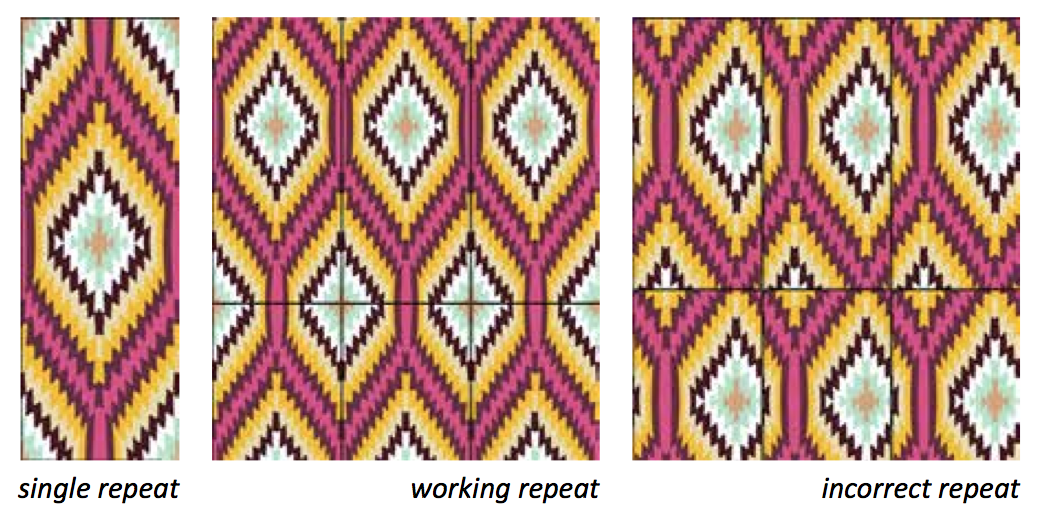
Non-Repeating Patterns, Placements & Photographic
We can also print non-repeating work such as photographs or placement prints.
If you have a non-repeating pattern you’d like duplicated just let us know how many copies you require and we will repeat your art across and down the fabric.
To print different non-repeating artworks assemble your artworks into a single file as shown to avoid additional set up fees.
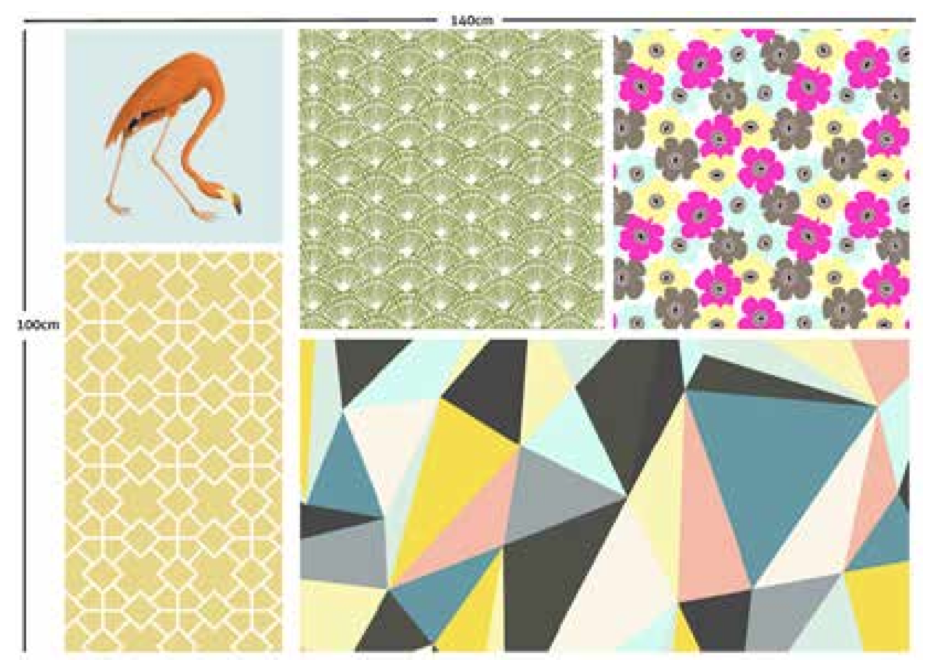
-
7.5. Saving My File
Saving My File
To save your file in photoshop be sure to select the correct colour mode.
Select RGB/8 Bit mode by selecting the mode in the Image menu as shown.
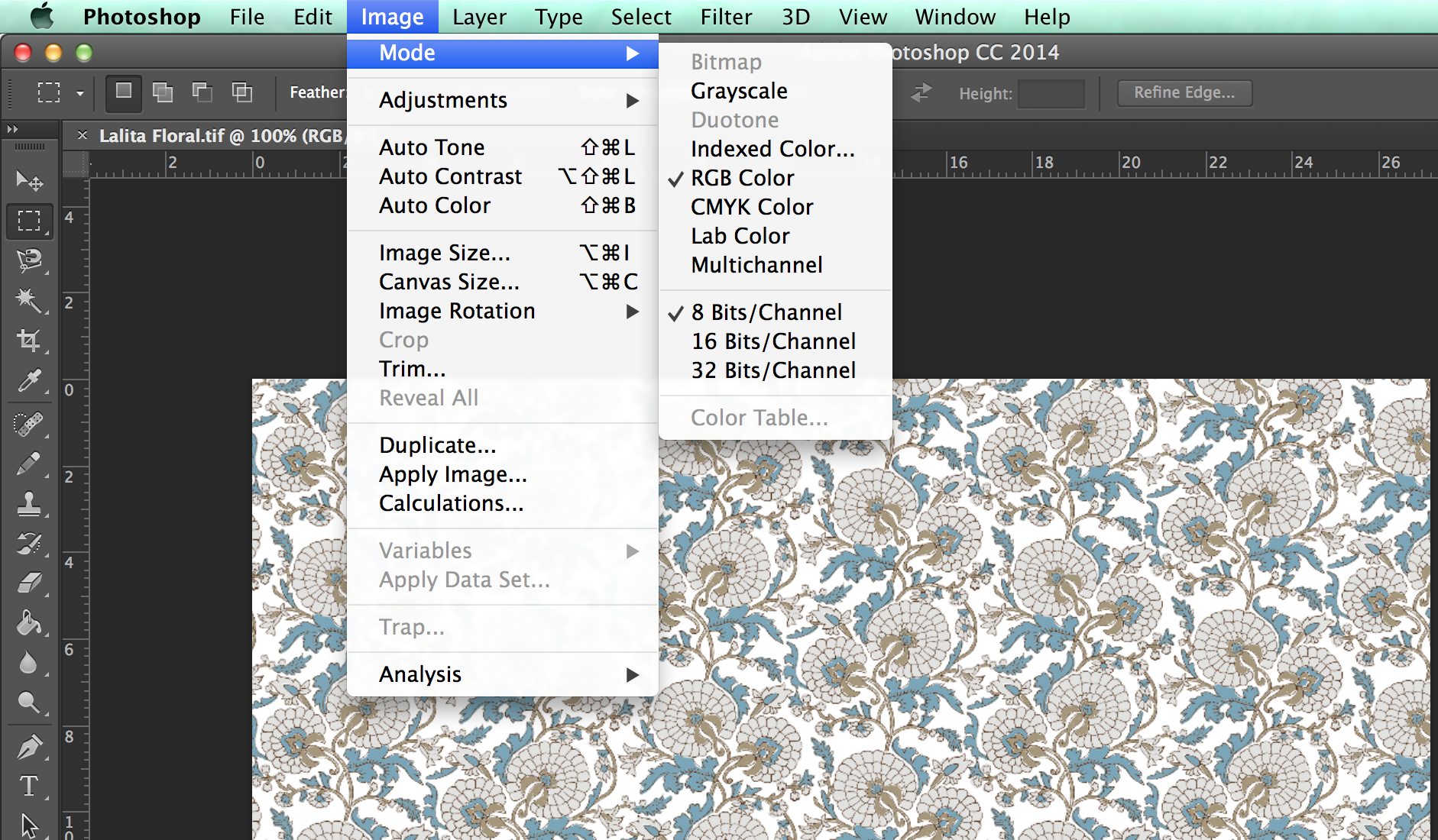
When saving your file select TIFF format from the Menu.
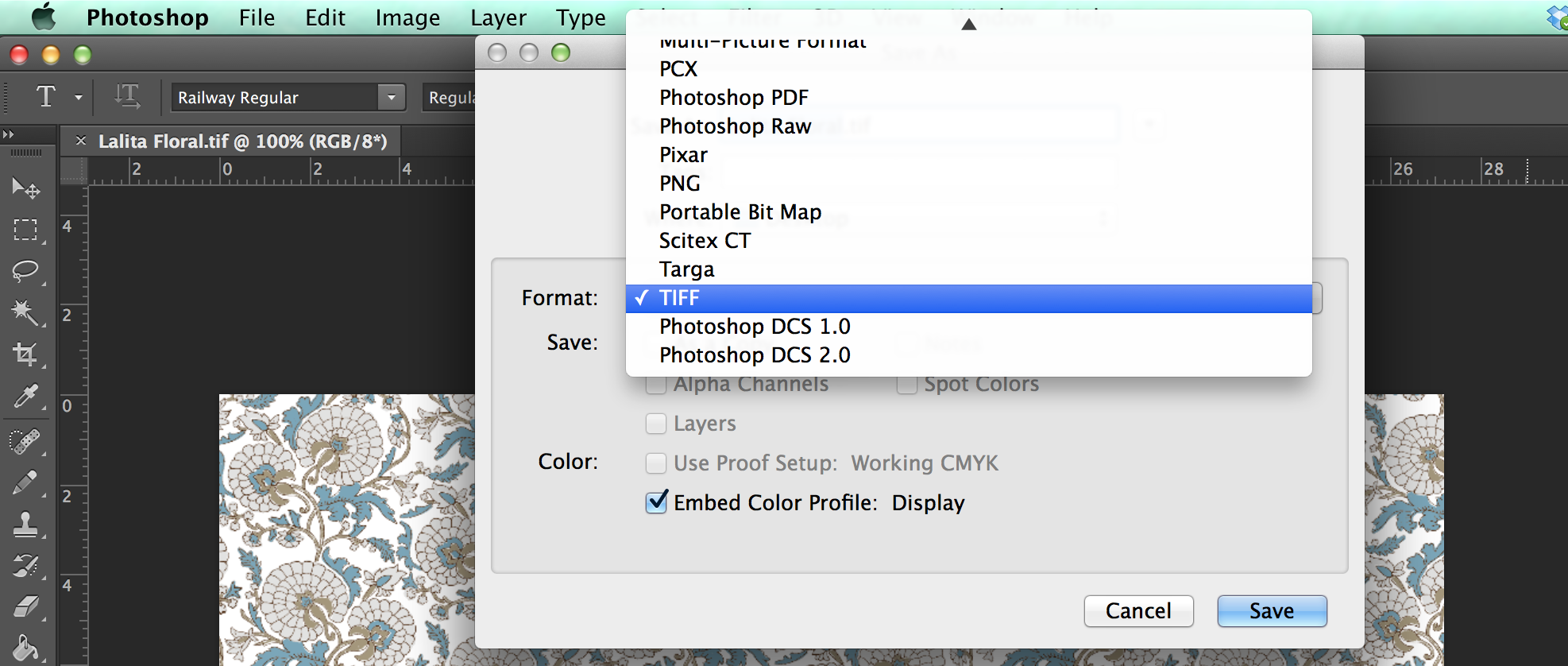
-
7.6. Colouring My Designs
Colouring My Designs
Maak's Colour Atlas for designers contains over 1300 colours and is available on any of our base cloths.
Once you have identified which print base(s) you will be printing on, you can order printed atlases for $60 + GST.
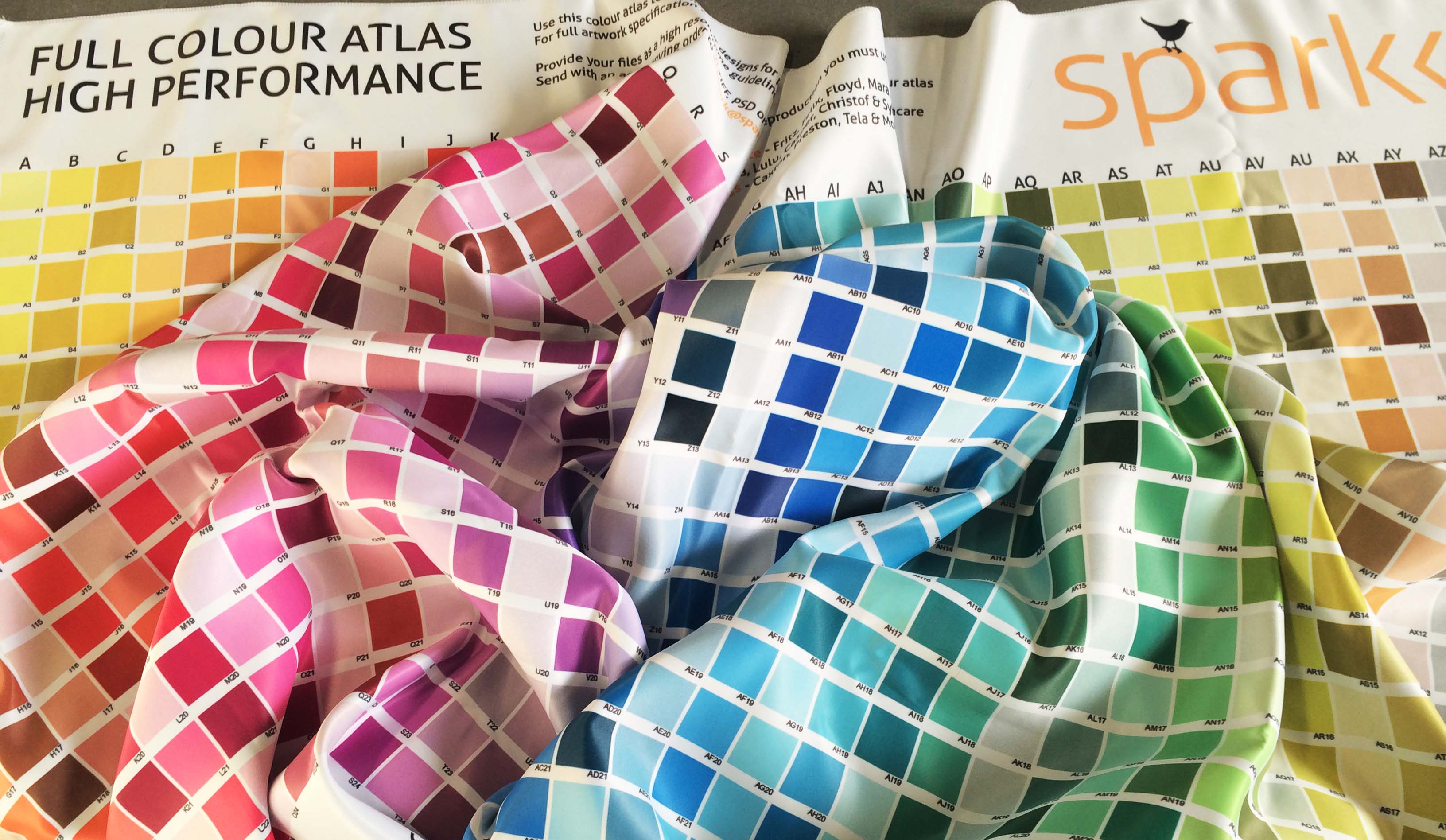
Once you have ordered your atlas we'll send you a digital copy, simply find your desired colour and match the grid reference with your photoshop colour picker. Once you have your colour you can use
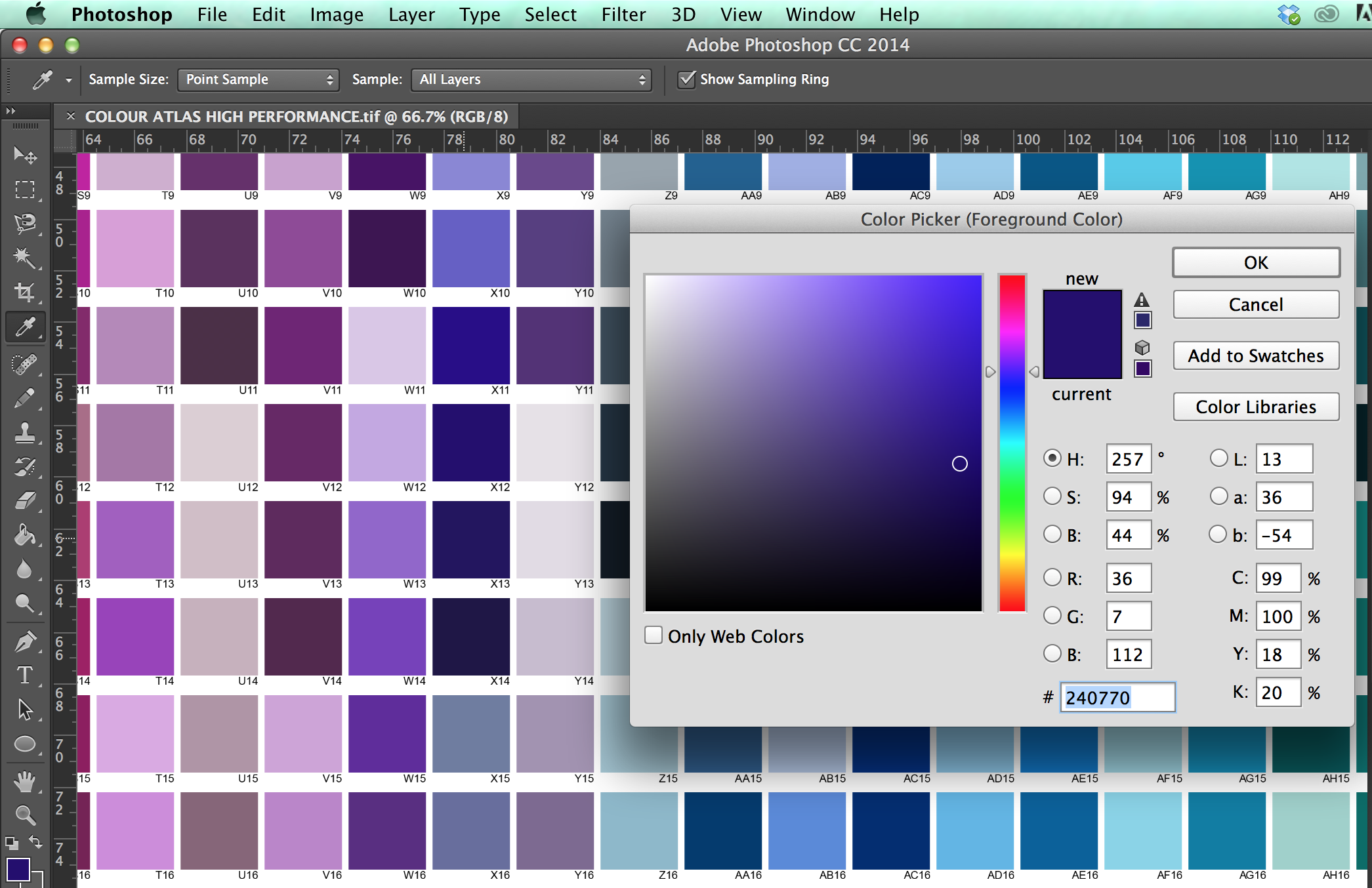
-
7.7. Design Services
Design Services
We provide a number of options when printing your designs depending on your needs.
File set up
Single design $55
2-6 designs $45 each
6+ designs $30 each
• Designs checked for issues, repeats, scales & colouring
• Approval strike-offs with two revisions per design included. Additional charges may apply for further revisions.
Custom Design Services - $90 per hour
Our studio is able to provide a number of design services to help complete your project. Once we have a clear understanding of what you need we will quote you based on the time needed to complete the job.
-
If you are having trouble getting repeats to work we can assist.
-
If you have an oversized image you would like to print as a mural we can cut up the image to correctly repeat across multiple panels.
-
If you have multiple images you would like to print in a single run we can put them all together in a single print file.
-
If your having trouble getting your colours to work or need colours you can’t find on our atlas we can match to pantone or paint
swatches.
-
Our studio can create original artwork to your brief.
-
-
-
8. Trade
-
8.1. Who is eligible for trade accounts?
Who is eligible for trade accounts?
Trade accounts are available for anyone who is legitimately in the Interior Design trade. This includes:
Interior designers & decorators
Architects
Upholsterers
Curtain makers
Homeware stores
Online retailersTo register for a trade account you need to have a registered business. Register your company through our website and we will check your details and approve your account.
Once approved we'll send you out a welcome pack including information & samples of print-bases and palettes.
-

